Over 80% of adults experience back pain at some point, often from something as simple as bending over. But here’s what most people don’t realize: a strong lower back isn’t just about the back muscles themselves. The secret lies in building your entire support system – your glutes, hamstrings, and core. These muscles work together like a team to protect your spine and keep you moving pain-free.
That’s where dumbbells come in. They’re the perfect tool for this job because they allow natural movement patterns while challenging your stability. You can target every muscle that supports your spine with just a pair of weights.
Here’s what we’ll cover: three foundational moves that are perfect for beginners and anyone dealing with back discomfort, four strength-building exercises for those ready to level up, plus a complete workout plan that puts it all together. We’ll also tackle the most common mistakes that could sabotage your progress.
Understanding your lower back
Your spine doesn’t work alone. Think of it like the mast of a sailboat – without the supporting ropes (your muscles), it would topple over.
The main players in your back support team include:
- Erector Spinae: These muscles run along your spine like two thick cables. They keep you upright and prevent your back from rounding forward.
- Glutes: Your body’s powerhouse muscles. Strong glutes take pressure off your lower back by properly positioning your pelvis.
- Hamstrings: These connect your glutes to your knees. Tight or weak hamstrings can tilt your pelvis and strain your back.
- Core Muscles: Including your deep abdominal muscles and diaphragm. They act like a natural weight belt, stabilizing your spine from the front.
Research shows that people with chronic back pain often have weak glutes and poor core stability. By strengthening these supporting muscles, you can reduce pain and prevent future injuries.
| Exercise | Difficulty | Weight needed | Primary muscles | Key benefits | Best for |
|---|---|---|---|---|---|
| Glute Bridge | Beginner | Light-Medium | Glutes, Core | Pain Relief, Activation | Back Pain, Beginners |
| Bird-Dog | Beginner | Light | Core, Stabilizers | Stability, Coordination | Rehabilitation |
| Suitcase Carry | Beginner | Medium-Heavy | Core, Obliques | Functional Strength | Daily Activities |
| Romanian Deadlift | Intermediate | Medium-Heavy | Hamstrings, Glutes, Erectors | Posterior Chain Strength | Overall Strength |
| Bent-Over Row | Intermediate | Medium | Lats, Rhomboids | Upper Back Strength | Posture Improvement |
| Good Morning | Advanced | Light-Medium | Erector Spinae | Spinal Strength | Injury Prevention |
| Renegade Row | Advanced | Light-Medium | Full Body | Total Stability | Athletic Performance |
Weight selection guidelines
Choosing the right weight is critical for both safety and progress. Here’s your starting point:
Beginners (new to exercise or recovering from pain):
- Glute Bridge: 5-10 lbs
- Bird-Dog: 2-5 lbs
- Suitcase Carry: 10-15 lbs
Intermediate (6+ months regular exercise):
- Romanian Deadlift: 15-25 lbs per hand
- Bent-Over Row: 10-20 lbs per hand
- Good Morning: 10-15 lbs
Advanced (1+ years consistent training):
- All exercises: Start with intermediate weights and progress based on form quality
- Renegade Row: Often requires lighter weights than you’d expect
Progressive loading rules:
- Master bodyweight versions first
- Increase weight only when you can complete all sets with perfect form
- Add 2-5 lbs per week maximum
- If form breaks down, drop the weight immediately
Safety first: when NOT to do these exercises
Your safety comes first. Avoid these exercises if you have:
Immediate red flags:
- Sharp, shooting pain down your legs
- Numbness or tingling in legs or feet
- Recent back surgery (within 6 months)
- Acute back injury or muscle spasm
- Fever with back pain
Exercise cautions:
- If bending forward causes pain, skip Good Mornings and RDLs
- If lying flat hurts, modify Glute Bridges by using pillows
- If holding weights overhead is painful, avoid that variation
Warning signs to stop immediately:
- Pain that gets worse during exercise
- New numbness or tingling
- Dizziness or nausea
- Sharp pain that takes your breath away
When in doubt, consult a healthcare provider or physical therapist before starting any exercise program.
The foundation – 3 essential moves for beginners and pain relief
Start here to build a foundation of strength and stability
These three exercises focus on control and proper muscle activation. They’re low-risk but highly effective for teaching your body how to move safely and building the stability your spine needs.
Exercise 1: Dumbbell glute bridge
The #1 move to activate your glutes and take pressure off your lower back
Your glutes are like the powerhouse of your lower body. When they’re strong and active, they support your pelvis and take stress off your spine. Weak glutes force your lower back to work overtime, leading to pain and injury.
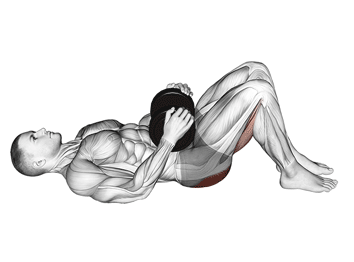
How to do it:
- Lie on your back with knees bent and feet flat on the floor
- Hold a dumbbell across your hips with both hands
- Squeeze your glutes and drive your hips up until your body forms a straight line
- Hold for 2 seconds at the top
- Lower slowly and repeat
Pro-Tip: Focus on squeezing your glutes at the top, not on arching your back. You should feel this in your glutes, not your lower back.
Exercise 2: Dumbbell bird-dog
The ultimate core stabilizer for spinal health
This move teaches your core to resist rotation and maintain a neutral spine position. It’s like training your body’s natural brace system. A strong, stable core is your spine’s best friend.
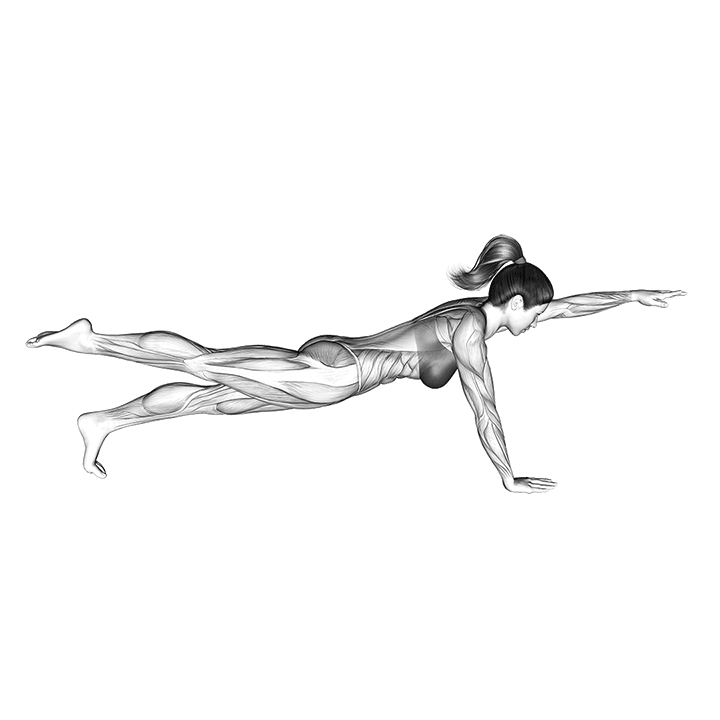
How to do it:
- Start on hands and knees with a light dumbbell in one hand
- Extend the opposite leg straight back while holding the weight
- Keep your back flat and hips level
- Hold for 3-5 seconds
- Return to start and switch sides
Pro-Tip: Imagine a glass of water on your lower back that you don’t want to spill. This mental cue helps you maintain perfect alignment.
Exercise 3: Suitcase carry
The functional move that builds real-world core strength
This exercise mimics carrying heavy objects in daily life – like that bag of groceries. It trains your core to stay rigid and prevents your spine from bending sideways under load.

How to do it:
- Hold a heavy dumbbell in one hand at your side
- Stand tall with shoulders back
- Walk forward for 20-30 steps
- Keep your torso upright and avoid leaning
- Switch hands and repeat
Pro-Tip: Fight the urge to lean away from the weight. Your torso should stay perfectly upright, as if you’re walking between two walls.
The strength-builders – 4 advanced exercises to forge a powerful back
Ready to level up? These exercises build serious lower back and posterior chain strength
Once you’ve mastered the foundational moves, these compound exercises will build serious strength throughout your entire posterior chain – the muscles along the back of your body that work together to support your spine.
Exercise 4: Dumbbell Romanian deadlift (RDL)
The king of posterior chain exercises
The RDL targets your hamstrings, glutes, and erector spinae (the muscles that run along your spine) all at once. It’s like a full-body strengthening move for everything that supports your back.
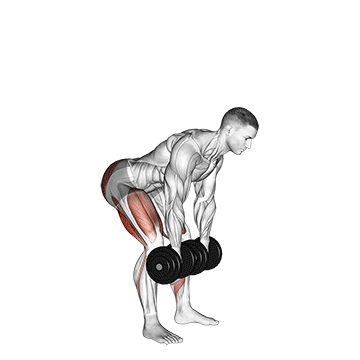
How to do it:
- Hold dumbbells in front of your thighs with feet hip-width apart
- Keep a slight bend in your knees
- Hinge at your hips and push your butt back
- Lower the weights until you feel a stretch in your hamstrings
- Drive your hips forward to return to standing
Common Mistake to Avoid: Don’t squat down or round your lower back. This is a hip hinge movement – your knees barely bend, and your back stays flat throughout. Think about pushing your butt back toward a wall behind you.
Exercise 5: Bent-over dumbbell row
Build a stronger shelf: develop your mid and lower back
This exercise strengthens your lats and the small stabilizing muscles along your spine. A strong upper back helps maintain good posture and takes pressure off your lower back.
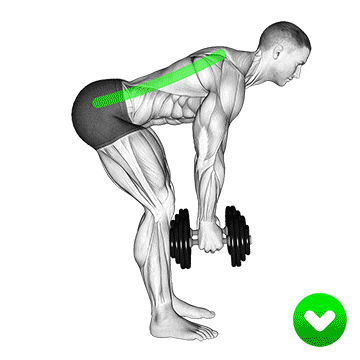
How to do it:
- Hinge at your hips with dumbbells hanging straight down
- Keep your back flat and core tight
- Pull the weights to your ribs, squeezing your shoulder blades together
- Lower slowly with control
- Keep your torso still throughout
Common Mistake to Avoid: Don’t use momentum or yank the weights up quickly. This should be a controlled pull using your back muscles, not your arms doing all the work.
Exercise 6: Dumbbell good morning
The often-overlooked exercise for specifically targeting the erector spinae
Good mornings directly strengthen the muscles that run along your spine. These are the muscles that keep you upright and prevent your back from rounding under load.
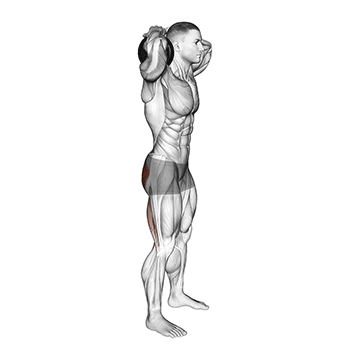
How to do it:
- Hold a light dumbbell against your chest
- Stand with feet shoulder-width apart
- Slowly hinge forward at your hips
- Go down until you feel tension in your hamstrings
- Return to standing by driving your hips forward
Common Mistake to Avoid: Start light and build up slowly. Going too heavy too soon can cause you to round your spine, which defeats the purpose and creates injury risk.
Exercise 7: Renegade row
The ultimate test of total core and back stability
This challenging move combines a plank with a rowing motion. It forces your core to work overtime to prevent rotation while your back muscles do the pulling. It’s like a full-body coordination test.
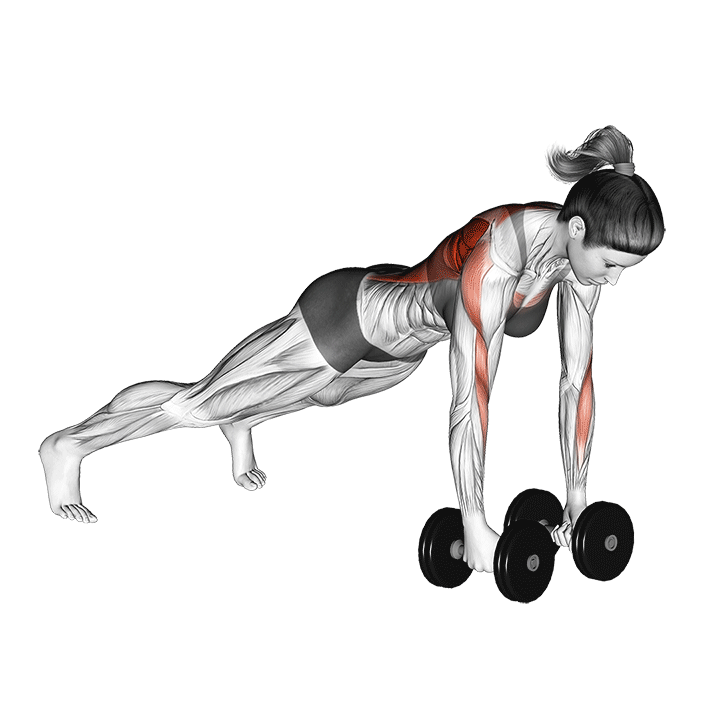
How to do it:
- Start in a plank position holding dumbbells
- Keep feet wider than shoulder-width for stability
- Row one weight to your ribs while holding the plank
- Lower slowly and switch sides
- Keep your hips as still as possible
Common Mistake to Avoid: Don’t let your hips rock from side to side. The challenge is maintaining that rock-solid plank position while rowing. If your hips are rotating excessively, use lighter weights or modify by dropping to your knees.
Troubleshooting common problems
What if… you’re not feeling it where you should?
“I feel glute bridges in my back instead of my glutes”
- Your glutes might be sleeping on the job. Try bodyweight glute bridges first
- Squeeze your glutes before you lift
- Place a pillow under your head to reduce back arch
“My lower back hurts after deadlifts”
- You might be rounding your spine. Practice the hip hinge with no weight
- Start with a higher range of motion
- Check if your hamstrings are too tight
“I can’t maintain form during renegade rows”
- Use lighter weights or no weights at first
- Try the move from your knees instead of your toes
- Focus on keeping your core tight like you’re about to be punched in the stomach
“Suitcase carries make me lean sideways”
- The weight might be too heavy – drop down 5-10 lbs
- Engage your core before you start walking
- Practice standing still with the weight first
Equipment alternatives
Don’t have the perfect setup? No problem. Here are smart substitutions:
| If you don’t have | Use this instead | Exercise modifications |
|---|---|---|
| Heavy dumbbells | Water jugs, backpack with books | Increase reps, slow tempo |
| Light dumbbells | Resistance bands, soup cans | Focus on muscle activation |
| Two dumbbells | One dumbbell, alternate sides | Unilateral training benefits |
| Any weights | Your own bodyweight | Master form first |
Your action plan: the bulletproof lower back workout
Don’t just learn the moves – put them to work with this weekly plan
Knowing the exercises is just the first step. Here’s how to put them together into a complete program that will build a strong, pain-free lower back.
The warm-up (5 minutes)
Never skip this step. Your lower back needs to be properly prepared before you load it with weight.
- Cat-Cow: 10 slow, controlled reps to mobilize your spine
- Glute Bridges (bodyweight): 15 reps to activate your glutes
- Bird-Dog (bodyweight): 8 reps per side to engage your core
The workout routines
Choose the routine that matches your current fitness level:
Pain-proofing routine (beginner/rehabilitation focus):
- Dumbbell Glute Bridge: 3 sets of 12-15 reps
- Dumbbell Bird-Dog: 3 sets of 8 reps per side
- Suitcase Carry: 3 sets of 20 steps per side
- Rest 60 seconds between sets
Strength-building routine (intermediate/advanced):
- Dumbbell RDL: 3 sets of 8-10 reps
- Bent-Over Dumbbell Row: 3 sets of 10-12 reps
- Dumbbell Good Morning: 3 sets of 10-12 reps
- Renegade Row: 3 sets of 6-8 reps per side
- Rest 90 seconds between sets
Frequency: Perform your chosen workout 1-2 times per week on non-consecutive days. Your muscles need time to recover and grow stronger.
| Week | Beginner routine | Intermediate routine | Focus |
|---|---|---|---|
| Week 1 | 2 sets, bodyweight/very light weights | 2 sets, moderate weights | Learn perfect form |
| Week 2 | 2-3 sets, light weights | 3 sets, moderate weights | Build consistency |
| Week 3 | 3 sets, light-medium weights | 3 sets, moderate-heavy weights | Increase challenge |
| Week 4 | 3 sets, medium weights | 3-4 sets, heavier weights | Test your progress |
| Time available | Recommended routine | Frequency | What to expect |
|---|---|---|---|
| 10 minutes | Foundation exercises only | 3x/week | Basic strength, pain relief |
| 20 minutes | Full beginner routine | 2x/week | Noticeable improvements |
| 30 minutes | Full intermediate routine | 2x/week | Significant strength gains |
| 45 minutes | Advanced + extra mobility work | 2x/week | Maximum results |
The cool-down (5 minutes)
Finish strong with these gentle stretches:
- Knee-to-Chest Stretch: Hold for 30 seconds each leg
- Child’s Pose: Hold for 60 seconds to gently stretch your lower back
- Gentle spinal twist: 30 seconds each side while lying down
What to expect: your results timeline
Setting realistic expectations helps you stay motivated and track progress effectively.
Week 1-2: learning phase
- Focus on movement patterns
- Mild muscle soreness is normal
- You might feel clumsy at first – this is expected
Week 3-4: activation phase
- Better muscle coordination
- Movements start feeling more natural
- Slight improvements in daily activities
Month 2: strength phase
- Noticeable strength gains
- Can use heavier weights
- Back feels more stable during daily tasks
Month 3+: transformation phase
- Significant functional improvements
- Reduced back pain incidents
- Better posture throughout the day
- Increased confidence in movement
| Exercise type | Pros | Cons | Best for |
|---|---|---|---|
| Dumbbell | Versatile, home-friendly, natural movement patterns | Limited maximum weight | Most people, home gyms |
| Barbell | Can load very heavy, efficient for strength | Requires more space and equipment | Experienced lifters, gyms |
| Machine | Guided movement path, very safe | Fixed range of motion, less functional | Beginners, rehabilitation |
| Bodyweight | No equipment needed, travel-friendly | Limited progression options | Beginners, maintenance |
Supporting your back health beyond exercise
Daily habits that make a difference
Desk setup for back health:
- Monitor at eye level to prevent neck strain
- Feet flat on floor with knees at 90 degrees
- Take standing breaks every 30 minutes
- Use a lumbar support cushion if needed
Sleep position tips:
- Side sleepers: pillow between knees
- Back sleepers: pillow under knees
- Avoid sleeping on your stomach
- Replace old mattresses that sag
Movement throughout the day:
- Take walking breaks every hour
- Do gentle stretches during TV commercials
- Park farther away to add walking
- Take stairs instead of elevators when possible
Nutrition and hydration:
- Stay hydrated to keep spinal discs healthy
- Anti-inflammatory foods like berries and leafy greens
- Adequate protein for muscle recovery
- Limit inflammatory foods like processed sugars
Working with healthcare professionals
When to seek professional help
Consider consulting a physical therapist or healthcare provider if:
- Your back pain persists despite consistent exercise
- You have pain that radiates down your legs
- You experience numbness or tingling
- Your pain interferes with sleep or daily activities
- You have a history of back injuries or surgeries
Complementary treatments
These exercises work well alongside:
- Physical therapy sessions
- Massage therapy for muscle tension
- Chiropractic care for alignment issues
- Yoga or stretching classes for flexibility
- Stress management techniques
Professional integration tips
- Share this exercise program with your healthcare provider
- Ask about specific modifications for your condition
- Report any pain or unusual symptoms immediately
- Follow professional advice over general exercise guidelines
- Consider working with a qualified trainer initially
Conclusion
A strong, pain-free lower back isn’t built overnight, but it’s absolutely achievable with the right approach. The key is understanding that your back doesn’t work alone – it’s part of a team that includes your glutes, hamstrings, and core.
Start with the foundational moves if you’re new to exercise or dealing with back discomfort. Master these basics before moving on to the strength-building exercises. Remember, perfect form beats heavy weight every time.
Research consistently shows that people who stay active and maintain strong supporting muscles have significantly less back pain throughout their lives. You’re not just exercising – you’re investing in decades of pain-free movement.
FAQs
How often should I do lower back dumbbell exercises?
Start with 1-2 times per week, allowing at least one day between sessions. Your muscles grow during rest, not just during exercise.
Can these exercises help with sciatica?
Many people find relief, but sciatica can have different causes. Consult a healthcare provider for persistent sciatic pain. These exercises may help if your sciatica is related to weak glutes or poor core stability.
What weight dumbbells should I start with for lower back exercises?
Beginners should start with 5-10 lbs for most exercises. It’s better to master the movement with light weight than to struggle with heavy weight and poor form.
Are dumbbell exercises better than machines for back strength?
Dumbbells offer more functional movement patterns and engage stabilizing muscles that machines don’t challenge. However, machines can be useful for beginners learning proper form or people with certain limitations.
How long before I see results?
Most people notice improved stability and reduced stiffness within 2-3 weeks. Visible strength gains typically appear after 4-6 weeks of consistent training.
Can I do these exercises every day?
No. Your muscles need recovery time to grow stronger. Doing these exercises daily could lead to overuse injuries and actually slow your progress.


